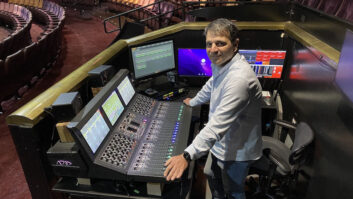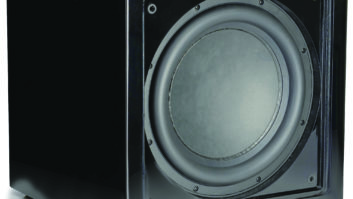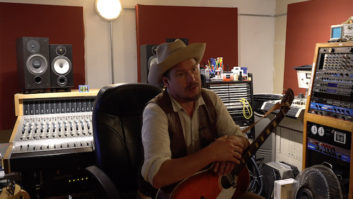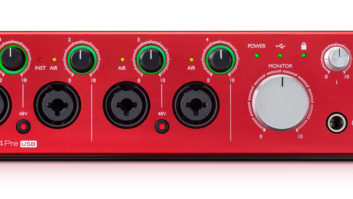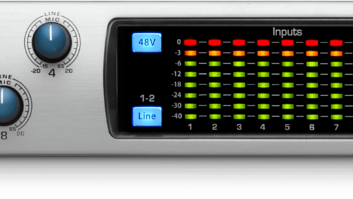THE STATE OF THE ART OF COMPUTER-CONTROLLED AUDIOAround 1992, the idea of computer-controlled sound systems struck a resonant note in the audio industry. MIDI Show Control and other device control standards were established, and AES/EBU point-to-point digital program transfer became a reality. A few pioneering companies offered computer-controlled audio products and systems based on proprietary designs. However, certain manufacturers and associations had undertaken a larger vision of interconnected audio systems. In this vision, diverse audio devices from different manufacturers would belong to computer-style local area networks and communicate via a set of standard digital languages (protocols).
Such networks would carry control and monitoring information, as well as distribute streams of multichannel digital audio. One or more system controllers would provide advanced control functions through appropriate software. Various digital signal sources would feed program into the network, various signal processors would modify those signals, and various destinations would receive the results, all via multiplexed network links, and all under the control of the controller(s).
In the complete vision, network audio systems would be defined mainly by the software running in their controller(s), not by the audio devices or their physical interconnection. This software would control the functions and signal flows, and different users might see the system differently. In other words, audio systems would become “virtualized.” The physical devices and the local network would be a platform for the implementation of these virtual audio systems.
Thus, a completely developed network audio system would have thefollowing elements: a genuine network architecture-not merely point-to-point transmission; computer-controllable devices, with control and monitoringinformation exchanged over a local area network, allowing comprehensive software control from one or more points; software-controllable signal distribution via the network; and multivendor interoperability.
Why Computer Control?Being software-based, a properly implemented network audio system can be changed without physical rewiring, with the ability to support complex and automatic functions. It can have advanced security and access control features, and highly human-engineered user interfaces. Such audio systems could interface with other systems (building, security, lighting). Its physical implementation (location, wiring) and audio performance (sound quality, acoustic output) could be upgraded transparently, with little or no change to operator interfaces, and it could be operated from diverse locations (local and remote).
By incorporating technology from the computing/communications industries, network audio system architectures get a “free ride.” Without investing huge sums in research and development, audio manufacturers can capitalize on the evolving technologies developed in those larger markets to offer increasingly improved network audio systems for less and less money.
As digital function becomes less expensive, the relative costs of knobs, switches, connectors, chassis and power supplies become a significant obstacle toward further cost reductions. Networkable devices effectively circumvent this barrier, as they require few knobs, switches or connectors, and typically pack a high degree of functionality into small, low-power, relatively inexpensive packages.
With a few mouse clicks, designers of virtual systems can add subtle processing functions, new signal paths, specialized control functions, and automatic monitoring elements. In most cases, the price of doing so will be only the cost of extra DSP cycles, which are cheap and getting cheaper. The creative opportunities are almost unlimited.
What happened to the dream?The grand idea of multivendor-interoperable, virtualized, network audio systems was losing steam by the mid-’90s, as audio manufacturers began realizing the financial commitment required to develop the technology. Few companies had solid business plans to indicate how they would profit from the result. New companies appeared, promising prepackaged network audio solutions that would eliminate most of the development cost, but they failed to deliver. Standards committees struck wishful publication deadlines but failed to meet them.
After retreating from the global concept, some companies focused inward on proprietary systems, while others simply put the matter of network audio aside. Today, the market features a small number of proprietary device control systems and a separate set of proprietary digital signal distribution systems, but rare are the systems that integrate both. There are few, if any, offerings that qualify for the full definition of “network audio system” given above.
Currently, implementing a fully featured network audio system requires assembling it piece by piece, or subsystem by subsystem, from an assortment of public-domain, licensable, and proprietary elements, and completing the integration with custom software and hardware. This is being done (and done well), but mostly for large systems with ambitious specifications and high budgets.
What about the future?Anyone who’s watched the progress of information technology during the past few years can imagine a future where installed network audio systems are part of the overall digital control, data and media networks that manage and support the operation of homes, buildings and other spaces. Such integration makes too much sense not to happen. The more difficult question is: How do we get there from here?
The early ’90s bloom served to acquaint the pro audio industry with the idea of comprehensive networking and to highlight some of its challenges. However, an additional stimulus in the form of home (i.e., consumer) networking is required to bring the industry to the next step. After years of talk, the major computing and entertainment companies from Microsoft on down are now beginning to do serious marketing of networkable products for the home.
Various sources have estimated the home networking market at approximately $140 million in 1999, $280 million in 2000, and $1 billion by 2002. It is estimated that 650,000 U.S. homes now have home networks of some kind. By 2003, this number is projected to be 10 million.
The home networking market currently has three thrusts: 1) Data, distributing data and Internet access to multiple personal computers; 2) Media, integrating video, audio, and computer-based media access and control; and 3) Control, appliance and building control and monitoring, including security.
These different areas have different network technology requirements. Data networking is currently dominated by Ethernet technology. Media networking, a new area, is currently being led by IEEE-1394 (FireWire) for consumer applications. Control networking has low bandwidth needs and low cost limits; it will probably be addressed by new technologies based on inexpensive special-purpose chipsets that provide bandwidths on the order of 1 megabit per second.
Initially, the three thrusts are being addressed by disparate product lines, but they will soon be integrated in various ways. In the consumer electronics industry, this integration is known as “convergence.” In the not-too-distant future, converged home network environments will be available off the shelf at a reasonable price, giving ordinary people access to an automated-and even intelligent-home environment.
The rise of home networking technology will promote pro audio networking in three ways: First, home networking will help pro audio customers see value in comprehensive networking of media and other systems, which means they will want more function and be willing to pay for it. Second, home networking will create a number of useful technologies that pro audio can use “for free.” Third, home networking will offer various products that will be usable directly (or in enhanced versions) in pro audio systems.
Beyond advancing the cause of pro audio networking, home networking will change the course of its development. For example, home network solutions will integrate audio, video, data and control (e.g. lighting, security) domains in a single interconnection scheme. Audio networking will only be one element of the package. On the pro side, current network audio standards and products will eventually have to become part of a larger suite of integrated multipurpose network protocols and technologies.
Responding to the rise of mass-market multipurpose networking will be a challenge for the pro audio world. Existing makers of proprietary audio control systems and audio distribution systems will have to interface or convert those systems to work with the new networks. Pro media standards groups will integrate their work with the new consumer-oriented standards. New manufacturers may appear. To help companies implement the new technologies, facilitative firms will offer multifunction networking services, knowledge and components for hire, license or sale.
Coming from the consumer side, these new technologies will undoubtedly lack features required in pro applications. For example, current versions of IEEE-1394 have capacity and physical distance limitations that will be problematic for some large installations. These limits will impede progress for a while, but most of the problems will eventually be solved by technology development or by enhanced standards. However, some pro features may simply not be implementable in networks built with consumer-oriented technology. In this case, the industry will have to develop bridges between the consumer technologies and more robust approaches, so that more robust (and expensive) technologies can be incorporated where required.
To design networked audio systems today, we need transition strategies. For systems with short lifetimes, we have no problem-we can use the same proprietary solutions we always have. For systems that won’t be changed much after installation, we can do the same, regardless of their anticipated lifetime. However, for systems that have longer lifetimes and may change after installation, the problem is more difficult, especially where multifunction/multimedia features are needed now or in the future. In such cases, system designs should incorporate interface points at which new technology can be attached when it becomes available. These might range from leaving room in racks for future devices that interface between new networks and old, to specifying high-bandwidth cable (or optical fiber) even if not immediately required.
As designers of evolvable systems, we will need to inform the owners of those systems about the potential system enhancement risks and rewards that lie in the future. To do that, we’ll need informed positions of our own. Creating and maintaining such positions requires active investigation-merely reading the new product sections of magazines is not sufficient. As the world becomes more digitally integrated, systems designers/implementers must become conversant with information technology architectures and technologies.
Someday soon for audio pros, multifunction multimedia networking will be reality. And if home networking finds acceptance, the pro audio world should be ready for widespread multifunction multimedia networking by the fall AES in 2002. For more information on multimedia, multifunction networking standards and technologies, check out these resources:
* Bill Gates’ address to the 2000 Consumer Electronics Show (CES) includes scenarios envisioning home networking: www.microsoft.com/billgates/ speeches/01-05ces.htm.
* An organization devoted to Microsoft’s “Universal Plug and Play” (UPnP) set of home network protocol standards: www.upnp.org/.
* Jini-a device control technology developed by Sun Microsystems and now supported by others-is based on the Java programming language, and is a competitor to Universal Plug and Play. It’s described at www.jini.org/whatisjini.html. See www.sun.com/jini/vision/ for application scenarios.
* The LonMark Interoperability Association’s mission is to “enable the easy integration of multivendor systems based on LonWorks networks.” LonWorks is a proprietary control network offering from the Echelon Corporation: www.lonmark.org.
* Intel offers a good starting place for IEEE-1394 information: www. intel.com/technology/1394/index.htm.
* mLan is a proposed standard IEEE-1394-based protocol suite originally developed by Yamaha: www1.yamaha.co.jp/tech/1394mLAN/. o Home Audio/Video Interoperability standard is an IEEE-1394-based media/control networking suite from a consortium of major manufacturers: www.omnilan.com/havi.htm.
* Digital Harmony is an IEEE-1394 facilitator company: www.digitalharmony.com.
* CobraNet-a licensable technology that uses fast Ethernet to distribute digital audio-is currently used by a number of pro audio companies: www.peakaudio.com/CobraNet/.
* “The Changing Face of Computing” is a free electronic newsletter that carries articles about home networking: www.compaq.com/rcfoc.
* The AES Technical Committee on Network Audio Systems has a home page at www.aes.org/technical/nas/. Also, AES standards working group SC-06-02 (e-mail to [email protected]) is working on audio applications of IEEE-1394, and working group SC-10 (e-mail [email protected]) is working on sound system control standards, notably the AES-24 application protocol.
* The Control Protocols Working Group of ESTA (Entertainment Services and Technology Association) is developing a network specification called ACN (Advanced Control Network) that may provide “the next generation standard for the distribution of data in lighting control networks.” Although currently identified as a lighting control protocol, ACN may have application in broader contexts. Check out www.esta.org/tsp/cpwg.html. ESTA has also published helpful recommended-practice documents on using Ethernet for entertainment lighting and other applications. See www.esta.org/tsp/index.html.
